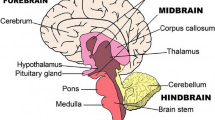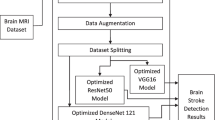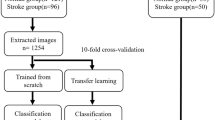Abstract
Brain injuries caused by strokes are one of the leading causes of disability in the world. Current procedures require a specialized physician to analyze an MRI image before making a diagnosis carefully, but the procedure can be costly and time-consuming. Artificial intelligence techniques play an essential role in analyzing this kind of image. This work proposes an end-to-end approach in three stages: pre-processing, for normalizing the images to the standard MNI space, as well as inhomogeneities and bias corrections; then lesion segmentation using a CNN network trained for Cerebrovascular Accidents and feature extraction; and, at the end classification for determining the vascular territory within which the lesion occurred. Four Deep Neural Network architectures and four Shallow Machine Learning models were designed, analyzed, and compared based on their performance scores, reaching an accuracy of 84% with the DL models and 95% with the Shallow ML models. The proposed method can be used as an automatic predictor for decision-making to assist health service providers of stroke lesion identification from MRI images.
Access this chapter
Tax calculation will be finalised at checkout
Purchases are for personal use only
Similar content being viewed by others
References
Carrillo-Mora, P.: Situación actual del manejo de las lesiones cerebrales adquiridas en adultos y su rehabilitación. Investigación en Discapacidad 3(4), 190–193 (2014)
Kuklina, E.V., Tong, X., George, M.G., Bansil, P.: Epidemiology and prevention of stroke: a worldwide perspective. Expert Rev. Neurotherapeut. 12(2), 199–208 (2012)
INEC:Estadística de defunciones generales del Ecuador (2020). https://www.ecuadorencifras.gob.ec/documentos/web-inec/Sitios/Defunciones
Moreno-Zambrano, D., Santamaría, D., Ludeña, C., Barco, A., Vásquez, D., Santibáñez-Vásquez, R.: Enfermedad Cerebrovascular en el Ecuador: Análisis de los últimos 25 años de mortalidad, realidad actual y recomendaciones. Rev. Ecuat. Neurol. 25(1–3), 17–20 (2016)
Loayza, F.R., Sola-Mora, J., Castro-Valladares, L., Litardo, J., Nuñez-Idrovo, L., Mora, H.: Pre-operative patient-specific alloplastic implant design and manufacturing: cranioplasty application. In 2018 IEEE Third Ecuador Technical Chapters Meeting (ETCM), pp. 1–5. IEEE, October 2018
Araújo, T., et al.: Classification of breast cancer histology images using convolutional neural networks. PloS One 12(6) (2017). https://doi.org/10.1371/journal.pone.0177544
Saver, J.L., et al.: Time to treatment with endovascular thrombectomy and outcomes from ischemic stroke: a meta-analysis. Jama 316(12), 1279–1289 (2016). https://doi.org/10.1001/jama.2016.13647
Singh, H., Meyer, A.N., Thomas, E.J.: The frequency of diagnostic errors in outpatient care: estimations from three large observational studies involving US adult populations. BMJ Qual. Safety 23(9), 727–731 (2014)
Sarkar, U., et al.: Challenges of making a diagnosis in the outpatient setting: a multi-site survey of primary care physicians. BMJ Qual. Saf. 21(8), 641–648 (2012)
Pelaez, E., Loayza, F.: A deep learning model to screen for Corona Virus Disease (COVID-19) from X-ray chest images. In: 2020 IEEE ANDESCON, pp. 1–6. IEEE, October 2020
Chilamkurthy, S., et al.: Deep learning algorithms for detection of critical findings in head CT scans: a retrospective study. Lancet 392(10162), 2388–2396 (2018). https://doi.org/10.1016/S0140-6736(18)31645-3
González-Villá, S., Oliver, A., Huo, Y., Lladó, X., Landman, B.A.: A fully automated pipeline for brain structure segmentation in multiple sclerosis. NeuroImage: Clin. 27, 102306 (2020). https://doi.org/10.1016/j.nicl.2020.102306.
Roura, E., et al.: Automated detection of lupus white matter lesions in MRI. Front. Neuroinform. 10, 33 (2016). https://doi.org/10.3389/fninf.2016.00033
McKinley, R., et al.: Fully automated stroke tissue estimation using random forest classifiers (FASTER). J. Cerebral Blood Flow Metabol. 37(8), 2728–2741 (2017). https://doi.org/10.1177/0271678X16674221
Viteri, J.A., Loayza, F.R., Peláez, E., Layedra, F.: Automatic brain white matter hypertinsities segmentation using deep learning techniques. In: HEALTHINF, pp. 244–252 (2021). https://doi.org/10.5220/0010360302440252,
Liew, S.L., et al.: A large, open source dataset of stroke anatomical brain images and manual lesion segmentations. Sci. data 5(1), 1–11 (2018). https://doi.org/10.1038/sdata.2018.11
Bisong, E.: Google Colaboratory. In: Building machine learning and deep learning models on google cloud platform. Apress, Berkeley, CA (2019). https://doi.org/10.1007/978-1-4842-4470-8-7
Lowekamp, B.C., Chen, D.T., Ibáñez, L., Blezek, D.: The design of SimpleITK. Front. Neuroinform. 7, 45 (2013)
Tustison, N.J., et al.: The ANTsX ecosystem for quantitative biological and medical imaging. Sci. Rep. 11(1), 1–13 (2021)
Chollet, F.: Keras: the python deep learning library. Astrophysics Source Code Library, ascl-1806 (2018)
Pedregosa, F., et al.: Scikit-learn: Machine learning in Python. J. Mach. Learn. Res. 12, 2825–2830 (2011)
Abadi, M., et al.: Tensorflow: large-scale machine learning on heterogeneous distributed systems. ar**v preprint ar**v:1603.04467 (2016)
Perona, P., Malik, J.: Scale-space and edge detection using anisotropic diffusion. IEEE Trans. Patt. Anal. Mach. Intell. 12(7), 629–639 (1990). https://doi.org/10.1109/34.56205
Fonov, V.S., Evans, A.C., McKinstry, R.C., Almli, C.R., Collins, D.L.: Unbiased nonlinear average age-appropriate brain templates from birth to adulthood. NeuroImage 47, S102 (2009). https://doi.org/10.1016/S1053-8119(09)70884-5
Hao, Y.: CLCI-Net: cross-level fusion and context inference networks for lesion segmentation of chronic stroke. In: Shen, D., (eds.) MICCAI 2019. LNCS, vol. 11766, pp. 266–274. Springer, Cham (2019). https://doi.org/10.1007/978-3-030-32248-9_30
Clèrigues, A., Valverde, S., Bernal, J., Freixenet, J., Oliver, A., Lladó, X.: Acute and sub-acute stroke lesion segmentation from multimodal MRI. Comput. Meth. Prog. Biomed. 194, 105521 (2020)
Garg, R., Oh, E., Naidech, A., Kording, K., Prabhakaran, S.: Automating ischemic stroke subtype classification using machine learning and natural language processing. J. Stroke Cerebrovasc. Dis. 28(7), 2045–2051 (2019)
Author information
Authors and Affiliations
Corresponding author
Editor information
Editors and Affiliations
Rights and permissions
Copyright information
© 2022 The Author(s), under exclusive license to Springer Nature Switzerland AG
About this paper
Cite this paper
Mena, R., Macas, A., Pelaez, E., Loayza, F., Franco-Maldonado, H. (2022). A Pipeline for Segmenting and Classifying Brain Lesions Caused by Stroke: A Machine Learning Approach. In: Rocha, A., Adeli, H., Dzemyda, G., Moreira, F. (eds) Information Systems and Technologies. WorldCIST 2022. Lecture Notes in Networks and Systems, vol 470. Springer, Cham. https://doi.org/10.1007/978-3-031-04829-6_37
Download citation
DOI: https://doi.org/10.1007/978-3-031-04829-6_37
Published:
Publisher Name: Springer, Cham
Print ISBN: 978-3-031-04828-9
Online ISBN: 978-3-031-04829-6
eBook Packages: Intelligent Technologies and RoboticsIntelligent Technologies and Robotics (R0)




